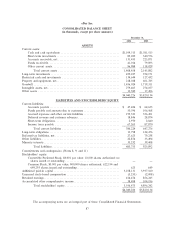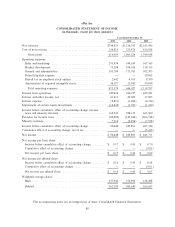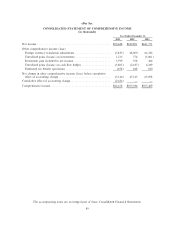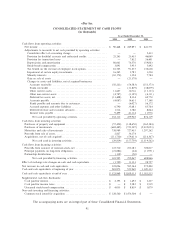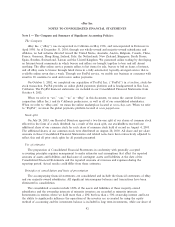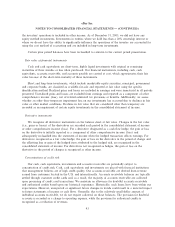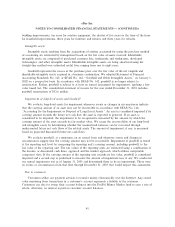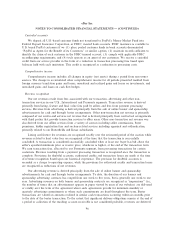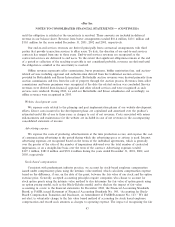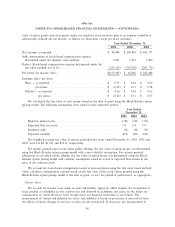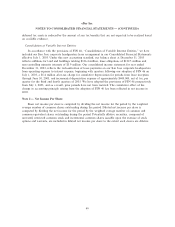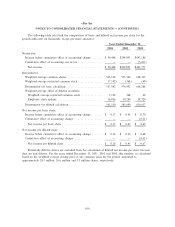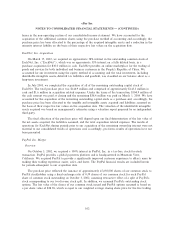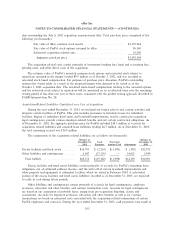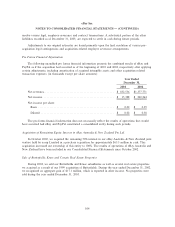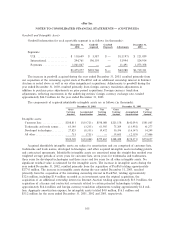eBay 2003 Annual Report Download - page 99
Download and view the complete annual report
Please find page 99 of the 2003 eBay annual report below. You can navigate through the pages in the report by either clicking on the pages listed below, or by using the keyword search tool below to find specific information within the annual report.eBay Inc.
NOTES TO CONSOLIDATED FINANCIAL STATEMENTS Ì (CONTINUED)
until the obligation is satisÑed or the uncertainty is resolved. These amounts are included in deferred
revenue in our balance sheet. Revenue from barter arrangements totaled $10.4 million, $10.1 million and
$10.1 million for the years ended December 31, 2001, 2002 and 2003, respectively.
Our end-to-end services revenues are derived principally from contractual arrangements with third
parties that provide transaction services to eBay users. To date, the duration of our end-to-end services
contracts has ranged from one to three years. End-to-end services revenues are recognized as the
contracted services are delivered to end users. To the extent that signiÑcant obligations remain at the end
of a period or collection of the resulting receivable is not considered probable, revenues are deferred until
the obligation is satisÑed or the uncertainty is resolved.
OÉine revenues represents seller commissions, buyer premiums, bidder registration fees, and auction-
related services including appraisal and authentication derived from the traditional auction services
provided by ButterÑelds and Kruse International. ButterÑelds auction revenues were derived primarily from
auction commissions and fees from the sale of property through the auction process. Revenues from seller
commissions and buyer premiums were recognized at the date the related auction was concluded. Service
revenues were derived from Ñnancial, appraisal and other related services and were recognized as such
services were rendered. During 2002, we sold our ButterÑelds and Kruse subsidiaries and accordingly, no
oÉine revenues were recognized in 2003.
Website development costs
We expense costs related to the planning and post implementation phases of our website development
eÅorts. Direct costs incurred in the development phase are capitalized and amortized over the product's
estimated useful life of one to three years as charges to cost of net revenues. Costs associated with minor
enhancements and maintenance for the website are included in cost of net revenues in the accompanying
consolidated statement of income.
Advertising expense
We expense the costs of producing advertisements at the time production occurs, and expense the cost
of communicating advertising in the period during which the advertising space or airtime is used. Internet
advertising expenses are recognized based on the terms of the individual agreements, which is generally
over the greater of the ratio of the number of impressions delivered over the total number of contracted
impressions, or on a straight-line basis over the term of the contract. Advertising expenses totaled
$127.1 million, $181.8 million and $321.4 million during the years ended December 31, 2001, 2002, and
2003, respectively.
Stock-based compensation
Consistent with predominant industry practice, we account for stock-based employee compensation
issued under compensatory plans using the intrinsic value method, which calculates compensation expense
based on the diÅerence, if any, on the date of the grant, between the fair value of our stock and the option
exercise price. Generally accepted accounting principles require companies who choose to account for
stock option grants using the intrinsic value method to also determine the fair value of option grants using
an option pricing model, such as the Black-Scholes model, and to disclose the impact of fair value
accounting in a note to the Ñnancial statements. In December 2002, the Financial Accounting Standards
Board, or FASB, issued Statement of Financial Accounting Standards No. 148, ""Accounting for Stock-
Based Compensation Transition and Disclosure, an Amendment of FASB Statement No. 123.'' We did
not elect to voluntarily change to the fair value based method of accounting for stock based employee
compensation and record such amounts as charges to operating expense. The impact of recognizing the fair
97


